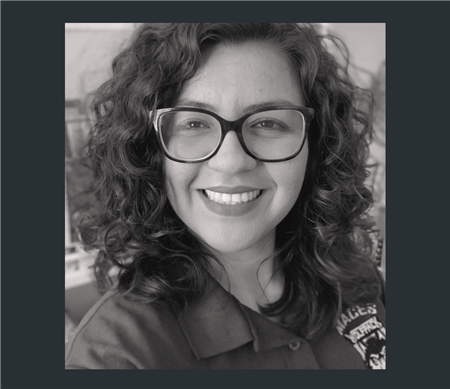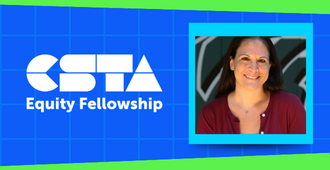Maria Camarena is a CS teacher at the Maywood Center for Enriched Studies, a 6th-12th grade school in Los Angeles with over 1,300 students. She is a strong advocate for girls in STEAM. You can see a glimpse of her students’ awesomeness and the pursuit to bring computer science to her community on Twitter (@Inspired2Code) and Instagram (@maces.cs and @maces.gwc). Her work and expertise reach beyond her classroom as she has planned and delivered numerous professional development sessions to staff, parents. District staff to integrate technology in students’ daily instruction and the importance of supporting computer science pathways.
What does school look like for you this fall, and how are you processing it?
For my school, this is the second week virtually back in the classroom, and things are winding down in a sense. Our school uses Schoology, and I would say the transition to this LMS has been a strong point of ours. Personally, everything still feels surreal. There is this cycle where I feel super prepared for classes, and I feel so incredibly unprepared with a sense of anxiety and lack of control. It is as if I have 1st-year jitters every day. Teachers are doing double the work to help prepare and implement in a virtual world. My goal is to bring consistency and community to build relationships, which is the only way to move forward in such a disconnected learning environment. Also, supporting my colleagues has been a passion over the past few weeks. The simultaneous feeling of frustration, dedication, and desire to lead a successful virtual classroom is very present, I understand it, and we are all trying our best.
As we are talking, you just finished up a virtual class at home. How are you balancing a work/life balance at present?
My husband is also a teacher, and we realized early on during the pandemic that we both cannot be in the same house teaching. He needs to be at another location. Honestly, I don’t know when the work stops, and home life begins. We have two elementary school-aged daughters, and we are trying to find ways to accommodate their needs. We reset various rooms in the house to set up a classroom environment. I’m unsure how virtual teaching will work with small children as they look for play and touch to learn – how does that work in a COVID-era? I applaud our elementary teachers.
Can you share what your journey has looked like becoming a CS teacher?
I’ve been working in the same area of the city since 2006, where I started working at a local high school teaching math. I committed to staying in this community because it represents me, a Hispanic/Latinx community. Even after budget cuts eliminated my role as a HS teacher, I stayed on as a local middle school teacher. When my current school was opening up, I applied for a Math teacher role and was turned down much to my disappointment. Weeks later, the principal reached out to me about teaching Intro to Computers. It was a time where I had nothing to lose, and I made the condition that if he hired me, he would let me teach CS discoveries. I advocated for what I believed in, creating a pathway for students in CS. In teaching Code.org’s CS discoveries, I knew we needed to have a pathway to teach CS from middle to high school. Today, all 7th graders at MaCES are taking CS discoveries, and we have eight classes of High school courses, including APCSP and APCSA. If you are not exposing computer science early to students, it is much harder to get them invested later.
How did you establish this pathway for CS at your school, and what strategies did you use?
Being mindful that I didn’t know a lot about CS at that time, so I did some research. Bringing a plate full of solutions and potential outcomes of getting CS throughout various grade levels would be more successful than suggestions. I started looking at the master schedule for my district to determine how I get students credit for college courses. AP courses was a pathway, and I needed to make that leap from CS discoveries to offering HS courses. Giving my principal the perspective of potential outcomes, we began with one section of Exploring Computer Science to test at the high school level while offering CS Discoveries to all 7th-grade students. This pathway of introducing CS early to middle schoolers helped develop an interest and to build capacity. The goal is to create a pipeline of students from middle to high school, to see CS students succeed, be interested in CS and get college credit early on.
How did you convince your administration to let 9th graders take AP?
It was a struggle. Our admin was not completely convinced on offering 9th graders the chance to take AP Computer Science Principles. I asked to please provide ten students to be part of the AP class. These ten students were our 7th graders two years ago and then were exposed to CS from the CS discoveries course. I knew they were ready, but I need it proof to keep advocating for CS. I presented the outcome of my sample size; I am proud to say that eight out of ten 9th-graders passed the AP exams huge strides because this meant that all students could take the class moving forward. If students want to take the AP Computer Science Principles class, don’t close the opportunity to let them expand their interest in CS.
Can you share how you have gathered such a robust school support system for CS and build a CS recruitment plan?
-
Get other teachers involved. We asked 6th, 7th, and 9th teachers to enroll in CS summer PD to help build capacity. Our goal is that these teachers start using a few CS concepts to help students make the connection that you can use CS outside of this one course.
-
One 9th grade biology teacher had the students create a flowchart in scratch and websites for their presentations.
-
A 7th-grade teacher is now teaching one course of CS.
-
A 6th-grade teacher, incorporates a lot of programming with scratch and code.org.
-
Create clubs that are surrounded by CS (accepting at middle school)
-
VEX Robotics club
-
Girls who code
-
CSHS
-
Get high school students to recruit and be your CS advocates. They tell their friends to join the classes, and we have seen this be very successful at the high school level. Last summer, I would to with a group these HS girls to get them interested in summer programs like Kode withKlossy and Girls Who Code Summer Immersion Program. My goal was to spark an interest in CS. They applied and got in. One of the young girls who participated in a CS summer program changed her whole schedule and even got five of her girlfriends to enroll in CS classes that same year. Getting other students to help spread the excitement is vital.
-
Show kids that there are people in the tech world that look like them. Most major tech faces are not what my students look like or identify as. We partnered with the
Nuevo Foundation and various Microsoft employees to speak to our students. Having the students be able to see someone that looks like them and ask questions ignites a spark. My students can catch a glimpse of a possible future because it comes down to the idea that “You can’t be what you can’t see.”
How are you keeping students engaged? We have heard from various members that students are struggling with being virtual and staying connected to learning.
-
Don’t force students to have their cameras on.
-
If they do have their camera on, thank them for showing kindness towards you. Trust me; it works; others will join.
-
Let them create our virtual norms. Our norms are written by the students for students to help them be present and thriving. Some of the norms they came up with are awesome. These are a few:
- Do not be distracted by your phone.
- Be on time.
- Be patient with your peers.
- Communicate with peers in breakout rooms.
- Use breakout rooms productively.
-
Break things up
-
Talk for 15 minutes, then have a poll or word cloud to get feedback from students.
-
Always build in 5-minute breaks between concepts.
-
Do exercises( stand up, stretch) with them to help break up the energy.
-
Get the students sharing. At the end of each day, we ask one student to share a video they created. Two truths and a lie, then all the students vote and have an excellent time connecting. It ends the day with something positive.
-
Find other ways to see that they are engaged, such as Daily Check-Ins, interactive presentations, etc.
Any last advice you would like to share with other CS teachers?
For every teacher, let’s give ourselves some grace. If you did everything that you could at the end of the day, and it still went wrong, that’s ok; tomorrow it will be another day.




